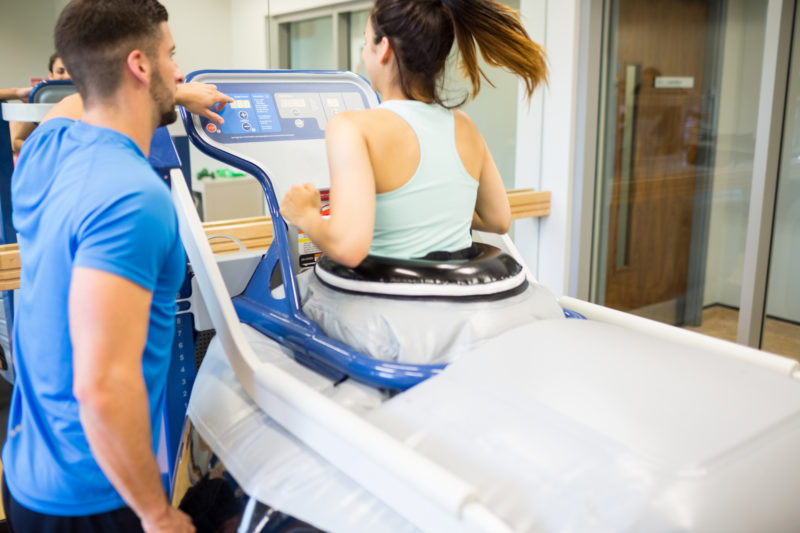Running is one of the best forms of exercise we can do every day. You don’t need a piece of fancy equipment to do it. Wearing comfortable running shoes paired with a simple shirt and shorts, and you are ready to work out a sweat.
There will be times when natural circumstances won’t let you run outside due to the weather, but no need to worry about missing out on your daily exercise. You can still run indoors using a treadmill. Indoor running may not be as refreshing as running outside, but what is important is you always get to exercise.
Speaking of treadmills, do you know what is an anti gravity treadmill? If not, or if you want to know more, we can help since we will look at the treadmill’s history. Then we will be focusing on one particular product: the anti-gravity treadmill.
Table of Contents
Brief History of a Treadmill
A treadmill is a piece of equipment usually seen inside the gym. You can pretend to be walking, running, or even climbing while on a treadmill. That is how we perceive a treadmill in these modern times.
The Treadmill for Labor
According to history, a treadmill or a treadwheel first came into existence during the latter part of the first century from the Roman Empire. They used the treadmill concept when they needed to lift heavy objects.
Then, in the 1800s, farmers needed a more stable and consistent source of power. The stationary machines they were using, which they later called horse treadmill, were powered by either wind or water.
It was then that they realized a horse could do the job better for them to have a stable power source. This idea is where the term horsepower came from.
They created smaller versions of the treadmill powered by domestic animals like dogs, goats, and sheep. They used these smaller versions for butter churns, cream separators, grindstones, and fanning mills.
The Treadmill for Humans
Then, in the Victorian Era, a British engineer named William Cubitt created a prison treadmill as a punishment device for prisoners. The inmates used the treadmill to pump water or grind corns. The government abolished the hard labor practice in 1889.
In 1952, a cardiologist from the University of Washington named Dr. Robert Bruce used the first modern treadmill for medical purposes. He monitored and diagnosed different heart conditions utilizing a treadmill.
Aerobic exercise and equipment became popular during the 60s and 70s, and Dr. Kenneth Cooper and Bill Staub presented the first exercise treadmill used at home
As we mentioned above, treadmills today are known to be stationary exercise machines so we can still walk or run indoors. It is still the most popular exercise equipment in the market today.
What Is an Anti Gravity Treadmill?
The anti-gravity treadmill was first invented in 1992 by a biomechanics researcher form NASA in the person of Robert Whalen. The first anti-gravity treadmill has an airtight chamber where the person’s lower body part is enclosed.
No one took notice of this unique treadmill until one company decided to take a risk. In 2005, the company AlterG bought a license of the machinery and made modifications before releasing a more valid and reliable anti-gravity treadmill.
From then on, they recognized the anti-gravity treadmill as a useful tool in clinical settings, especially for those undergoing physical rehabilitation. It removes the weight from the user; hence, the name anti-gravity. Recuperating patients from leg or foot injuries use this device to speed up recovery without experiencing any pain.
How It Works and How to Use
The user puts on a neoprene short on top of leggings or another pair of shorts before stepping on the treadmill. Once inside, and the lower half of the body is trapped, they can then set the level of lightness they prefer. After that, they can start doing physical rehabilitation exercises, like moving their legs and feet.
Letting them do the exercises even after an injury lessens the recovery period for the individual. Using the anti-gravity treadmill for physical rehabilitation is also safer because they don’t apply pressure on the injured part.
The machine functions much like a regular treadmill with different speed settings for both walking and running. In a clinical setting, the therapist can see the movement of the person’s legs and feet through the machine’s transparent sides and back cover.
Benefits
Anti-gravity treadmills offer a lot of benefits, especially in the clinical setting, but we will only be discussing some of the most important.
- Adjustable
You don’t need to be a professional health buff to use the anti-gravity treadmill. The machine is equipped with multiple settings, so you can choose one which you feel comfortable but still ensures positive results.
- Faster Recovery Time
As we mentioned earlier, using the anti-gravity treadmill allows the person to move their injured legs and feet to mend faster compared to the manual process of rehabilitation. With the anti-gravity treadmill’s ability to lessen a person’s body weight, they focus the exercises on the injured part without applying any pressure, so the person does not feel any pain.
- Safe
The company which manufactures the anti-gravity treadmill makes sure that using the equipment not only produce results but is also safe for all users before they released it to the market. Just make sure that all instructions are followed.
- Multipurpose
We have been focusing on the treadmill’s benefit for those undergoing rehabilitation, but this device is also applicable for anyone and everyone who wants to exercise. The machine is suitable for those who want to boost strength and mobility, especially athletes. They can build up their confidence while training their moves without any pain.
Going back to the clinical aspect of this device, it is most beneficial for those needing rehabilitation like those suffering from joint pains due to arthritis and those who need physical therapy after a stroke.
Conclusion
So, what is an anti gravity treadmill? To sum it all up, the anti-gravity treadmill helps simplify the rehabilitation of a person, speed up recovery time, and improve the physical therapy process. It can also be used by individuals who want to have daily exercise without leaving the comfort of their own home.
https://en.wikipedia.org/wiki/Treadmill
https://blog.lifefitness.com/the-history-of-the-treadmill
https://www.treadmillpros.com/anti-gravity-treadmill/
https://www.athletico.com/2017/09/15/benefits-alterg-anti-gravity-treadmill/







